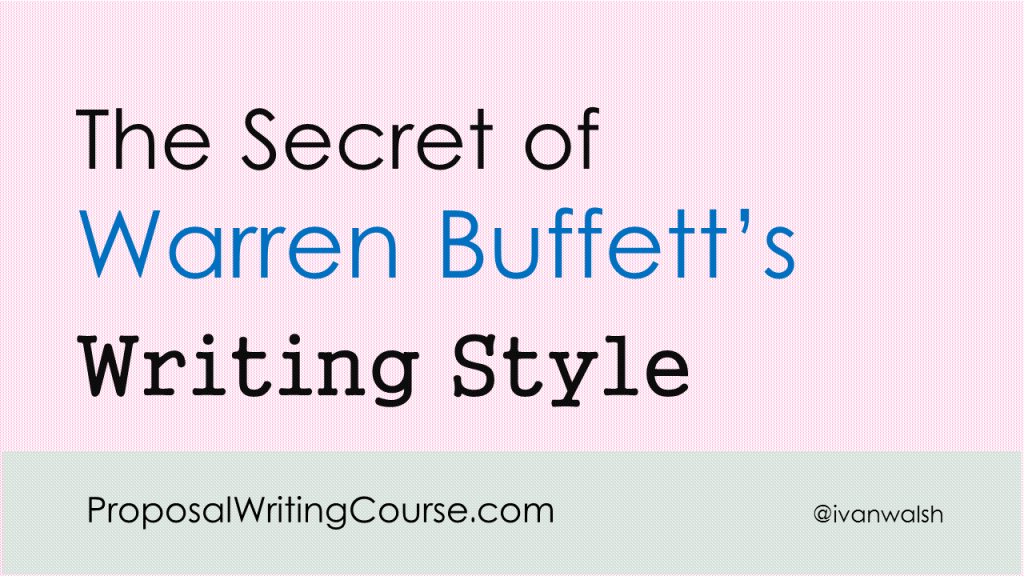What I like about Warren Buffets Annual Reports is that he says so much with so few words. And loses nothing in the process. For those of us who make a living writing business documents there are a few lessons to be learnt here.
Why The Executive Summary is Important
The Executive Summary of any business document is the first impression you make on the reader. If your business plan’s executive summary is poorly written, dull, or cut/pasted together it will hardly get noticed and the effort you put into the rest of the document won’t be seen.
Instead, set aside two or three hours and write the best Executive Summary you can. Challenge yourself to write three hundred words that excite you, generate interest, and paint a picture of your company. People want to read about other people. Don’t forget the power of human interest. In the end, they’re going to do business with you – not your product.
‘The business schools reward difficult complex behavior more than simple behavior, but simple behavior is more effective.’ Warren Buffett
How to Write an Executive Summary that generates interest
Your Executive Summary should excite the reader and help them understand the key results and conclusions in your business document, whether it’s your business proposal, business plan, annual report, case study or white paper.
Looking for inspiration?
Read the Annual Reports written by Warren Buffett and you’ll see how he does it. You know he has confidence in his company. He highlights the goods news in a nice understated way and delivers the less pleasant results with the same even tone.
Executive Summary Definition
Here’s one definition from The Handbook of Technical Writing, “An executive summary is to consolidate the principal points of a report in one place. It must cover the information in the report in enough detail to reflect accurately its content but concisely enough to permit an executive to digest the significance of the report without having to read it in full….”
Characteristics of a Well-Written Executive Summary
While this is a business document in the tradition sense, you must still find ways to stimulate the reader’s interest, make them want to turn the page and take some action.
- Executive summaries must be original.
- Executive summaries must not be cut-and-pastes extracts from the main document.
- Executive Summary should provide unique information not contained anywhere else.
- Executive summaries are standalone documents. The reader, for example, an investor, should be able to grasp your over-arching aims without having to read the entire document.
Documents That Require Executive Summaries
Some business documents require summaries, others don’t. Write an executive summary for the following types of documents:
- Grant Applications
- Standards
- System Design Documents
- Technical Reports
- Training Plans
- White Papers
Documents That Do Not Require Executive Summaries
You do NOT need to write an Executive Summary for shorter documents or certain technical publications, such as:
- Functional Specifications
- Meeting minutes
- Release Notes
- Status Reports
- User Manuals
- Workshop reports
Executive Summary Format & Guidelines
These are guidelines for your Executive Summary. They’re not set in stone, so adjust where necessary. The summary should cover the:
- Purpose
- Scope
- Methodology
- Results
- Conclusions
In general, you can write it as follows:
- First paragraph answers: “What is this document about?”
- Summary answers “How did you get the information?”
- Expand on the Software Development process (if applicable)
- Facts
- Results
- Conclusions
- Findings Note: present facts in tabular format.
- Recommendations
What doesn’t go in the Executive Summary?
Other information that doesn’t go in the Executive Summary includes:
- Acknowledgments
- Background data
- Cross-references
- Footnotes
- Industry updates
- Justifications
- Objectives
- Project history
- References
Remember to close your executive summary will a strong summary statement. This must persuade the reader that your business is a winner and the only way to do this is to turn the page and learn more about your company.
Final Tips for Writing the Business Plan’s Executive Summary
Provide a summary. The business plan itself gives the financial details.
- Use strong and positive language.
- No more two pages long. Don’t pad your business plan’s executive summary with fluff.
- Generate interest by enticing your reader to read the rest of the business plan, not tell him everything.
- Read it aloud. Does it read well or sound artificial? Is it clear and succinct?
- Adjust the executive summary for your respective audience. For example, if you want to attract investors, focus on the opportunity your business provides investors and why this opportunity is so special.
- Put yourself in your readers’ shoes. Does the executive summary really make you feel excited? If not, why?
The final word goes on Warren. Here’s his take on gold, “It gets dug out of the ground in Africa, or someplace. Then we melt it down, dig another hole, bury it again and pay people to stand around guarding it. It has no utility. Anyone watching from Mars would be scratching their head.”
Make sense?
About the Author: Ivan Walsh provides Business Tips for Smart People on Klariti.com. His also runs the Business Planning Blog at http://www.ivanwalsh.com
PS: The Business Plan Template is available from our partner here.
